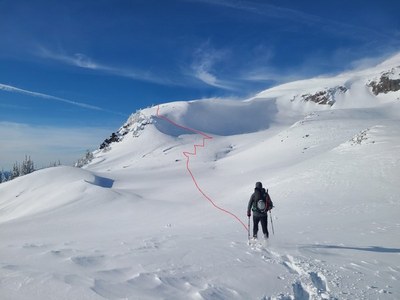
Avalanche Safety & Snowshoeing Course
Clinic: Practicing Terrain Choices & Rescue Drills
This course is set up for snowshoers only and those who are used to their winter gear, and traveling on beginner & basic snowshoeing trips on a powder day at minimum.
- Thu, Jan 21, 2021 - Fri, Feb 26, 2021
- Committee: Seattle Snowshoeing Committee
- Members: $50.00
- Availability: 11 (15 capacity)
- Cancellation & Refund Policy
THIS COURSE HELPS YOU TO actively participate in the decision-making process on your winter trips and also practice avalanche rescue drills.
prerequisite: MUst have actively participated in the 'WINTER TRAVEL: TRIP PLANNING' course or display the skills taught in that course (elaborate more on your experience in the application form).
COURSE OUTLINE:
- Before each field trip, maps with tentative routes will be provided, about 5 days in advance. The participants will plan their trip using their skills learned in the "Winter Travel: Trip Planning" course.
- On the morning of the trip, the group will come together and discuss the plan for the day, check their gear, and start traveling.
- The morning part of the trip will include practicing rescue drills.
- The afternoon part of the trip will include traveling in the backcountry, observing snow and route conditions, and change the course as needed by discussing the concerns with the group.
- At the end of the trip, the group will get together to debrief the actions, decisions for the day.
MORE TRIPS WILL BE ADDED AS the leaders (volunteers) become available. you are welcome to join the waiting list on this course to be notified of these new trip postings.
please consider the following before signing up:
- Click 'request leader's permission' and state your snowshoeing experience.
- Once approved, register for the course and pay the fees or sign up on a waitlist.
- Sign up for an available Field Trip.
This is a full-day small-group Field Trip at one of several locations such as Paradise in Rainier National Park, Artist Point near Baker Ski resort, or Snow Lake in Snoqualmie. - Also, note the following:
- While this is a foundational course, a moderate physical conditioning level is necessary. The field trip involves approximately 4-5 miles of travel round-trip and up to 1200 feet total elevation gain on snowshoes. This is the equivalent of approximately 8-10 miles and up to 2,400 feet elevation gain if wearing hiking boots on the trail.
- When new trips will be added, the individuals on the waiting list will be offered to sign up for the trip and pay the fees for the course at the same time.
THIS COURSE DOES NOT REPLACE AIARE'S LEVEL-1 OR AVALANCHE RESCUE COURSE.
COVID-19 CONSIDERATIONS
For the 2020-2021 season, all Seattle Snowshoeing courses and trips follow The Mountaineers COVID-19 Guidance for WA Phase 2. All participants must follow The Mountaineers COVID-19 Code of Conduct.
Before signing up for this course please be sure you have access to a winter-capable vehicle.
This course has no scheduled activities.
Every person's clothing needs are different. Some people get colder more quickly than others. Remember: NO COTTON. If you don't have any of this gear, try borrowing it from friends before you spend money.
For the field trip, you must bring the Ten Essentials and Clothing & Equipment.
TEN ESSENTIALS: Map (provided to you), compass, sunglasses and sunscreen, extra clothing, emergency shelter, headlamp/flashlight, first-aid supplies, fire starter, matches, knife, extra food & water. Sun protection is a must. Snow reflection is highly damaging to eyes; UV damage and sunburns are common if proper protection is not used.
CLOTHING & EQUIPMENT
- Pack (large enough for all winter gear)
- Snowshoes
- Ski Poles/Trekking poles with baskets
- Sturdy, lug-soled, waterproofed boots
- Clothing Layers (no cotton)
AVALANCHE RESCUE GEAR
- Avalanche Beacon
- Metal Shovel
- Avalanche Probe
Inner Layer:
- Wicking Liner socks, 2 pairs (one pair worn, other pair carried)
- Synthetic Warm Underwear, top & bottom, 2 sets (one set worn, other set carried)
- Liner gloves, (+extra set in pack)
Insulating Layer:
- Outer socks, 2 pairs (one pair worn, other pair carried)
- Pants, synthetic fleece or wool. Soft-shell or sturdy hiking pants suffice for many.
- Shirt or sweater, synthetic fleece or wool
- Mittens or gloves, 2 pairs (one pair worn, other pair carried)
Protective Layer:
- Rain parka with hood – waterproof & breathable preferred; remember, coated nylon doesn’t breathe and traps moisture under the clothing.
- Rain pants – waterproof & breathable preferred to avoid trapped moisture.
- Long gaiters. Be sure they fit your boots correctly so that snow doesn’t crawl underneath. GoreTex or insulated gaiters are not necessary.
- Hats (one for warmth; one for sun protection).
- Wind jacket (which may be your rain parka). A fleece or wind stopper vest is also handy if it is warm.
- Scarf or neck gaiter if you tend to get cold easily.
Additional Recommended Equipment/Supplies for the Field Trip:
- Foam sit pad
- Hand and toe warmers
- Toilet paper, sealable plastic bags, and hand sanitizer
- Pack cover
- Dry clothes and shoes in your car for the trip home
- Garbage bags in your car for wet gear
- Camera and extra batteries, if desired
There are no materials for this course.
